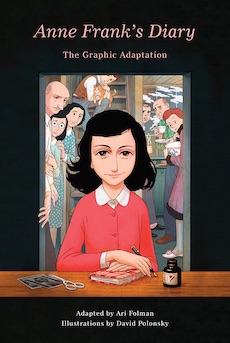By Carol A. Leibiger
The diary kept by Anne Frank, who would have celebrated her 90th birthday this year, is acclaimed as an iconic text of Jewish life under Nazi oppression as recounted by a talented and perceptive teenage writer. A gift received for her 13th birthday, Anne’s diary accompanied her into hiding in 1942 and was her constant companion and confidante until her capture in August 1944. (Anne died of typhus in the Bergen-Belsen concentration camp in early 1945.)
At the request of the Anne Frank Fonds, the Swiss foundation established by Otto Frank to support the diary’s continued publication, Israeli director, screenwriter, and composer Ari Folman has collaborated with animator David Polonsky to adapt the diary in graphic form. Based on the 50th-anniversary The Diary of a Young Girl: The Definitive Edition (1995), the adaptation is richly and imaginatively illustrated. It engagingly presents the highlights of Anne’s diary, rendering her descriptions of life before and in hiding and including her reactions to and reflections on her personal life, her interactions with family members, other inhabitants of the annex, and their Dutch helpers, as well as life under the Nazi regime.
In order to render Anne’s diary graphically, Folman has abridged the original text, omitting some entries and combining others. In most cases the abridgment simply removes entries with repetitive content. For instance, Anne’s often stated jealousy of and comparison of herself with her older sister Margot are fused by Polonsky into a single page of illustrations that powerfully communicate Anne’s feelings. A less useful abridgment entails the omission of Anne’s comments on previous entries. The diary was not merely a receptacle for Anne’s thoughts and feelings about her current life. She also engaged with past entries, commenting on them from a distance of one or two years, demonstrating growing maturity, sensitivity, and moderation. None of these reflective comments are included in the adaptation, resulting in a less nuanced, more linear account than that of the diary. While most of the abridgment of content is not noticeable, one combination introduces a factual error. According to the diary, the Frank family celebrated Hanukkah and the feast of St. Nicholas (December 6) concurrently while in hiding. The adaptation conflates the feast of St. Nicholas with Christmas, indicating that the Frank family celebrated Hanukkah and Christmas at the same time, which was not possible according to the calendars of 1942 and 1943. Moreover, there is no evidence in the diary that the Franks celebrated Christmas, beyond exchanging presents with their Dutch helpers.
Anne Frank’s diary is one of the 20th century’s most significant texts; it remains relevant as a personal story of the transcendence of the human spirit in the face of great evil. Anne Frank’s Diary: The Graphic Adaptation is a welcome addition to the adaptations of Anne’s diary. This visually powerful and textually engaging adaptation will surely gain new readers for The Diary of a Young Girl and thus contribute to the endurance of Anne Frank and her legacy.
Carol A. Leibiger (ΦΒΚ, University of Connecticut, 1977) is an associate professor in the I.D. Weeks Library at the University of South Dakota and a resident member of the Alpha of South Dakota chapter of Phi Beta Kappa.




